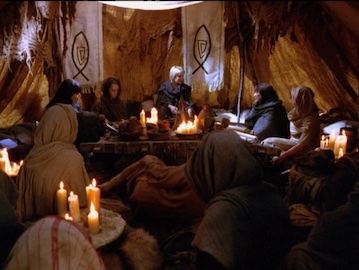
I’ll talk more about my definition of #Xena’s canon, & how I intend to comply with it, next week, but a big part of it is its referential style. That is, the way it borrows from various sources. Without those, it’s a very different show, in my opinion.
In keeping with that, I want to make sure I’m also borrowing from the same, or similar types, of sources. Since Greek theatre was a big part of the show, I plan to also incorporate it. It’s not hard, but for this story, it’s a bit tricky.
I draw upon a number of Greek plays, but the main inspiration is “Proteus,” a Greek comedy that Aeschylus wrote as the brief ending for his famous Oresteid trilogy (the only surviving Greek trilogy from its golden age). It’s difficult to borrow from it because it’s lost!
Only 1 Greek comedy survives, & half of another, so we know what the genre was like. We can use our imaginations to figure out how “Proteus” must’ve looked. We know the general plot, & we have a single surviving quote, about a slain dove.
We don’t know anything about the context of this quote. What did this poetic image mean? Since “Rock of Ages” is a story about Eve, a disciple for Peace, I use it as a symbol of endangered peace. In Homer’s “Odyssey,” Proteus is a wizard, & sea god, who lives on an island.
Helen of Troy’s husband, Menelaus, lands on this island, en route from the conquest of Troy, & needs directions home (or he’ll be lost, like Ulysses, for 10 years). He meets Proteus’s daughter, who tells him the secret of persuading her father to help him:
Because he’s the God of Change, a magical shape-shifter, Menelaus’ll need to catch him & not let go until he stops changing shapes. It works! Menelaus gets directions home, while finding out his brother Agamemnon got home 1st but was killed (i.e., the plot of the Oresteid.
Because this is a “satyr” play, as Greeks called their comedies (they used goatmen as comedy relief), a typical Greek myth gets turned into a screwball comedy as a result. I love the themes of change, romance, family strife, & bawdy hijinks all in the service of peace.
So it’s the perfect inspiration for this webcomic. I want to glean its details for use in “Rock of Ages,” just like the show runner clearly did elsewhere for #Xena. How to do that if the play is lost? By writing it and drawing it myself!
Whenever I got stuck in the story, I would consult my version of “Proteus”, its plot, motifs, & images. It worked! It provided a general unifying logic to “Rock of Ages” that kept the story on track. This mini-comic will be the first part of this project that I’ll post.
Because it’s unabashed & a bit bawdy (though nothing you wouldn’t see in a Danny Kaye movie), I modeled it after “Jack of All Trades,” & took inspiration from Bruce Campbell in shaping the performance of the lead role of Menelaus.
It’ll be drawn in the style of Disney’s “Hercules” cartoon, which came out shortly before “Hercules and Xena: The Battle For Mt Olympus”. Disney is an influence for me, drawing-wise, so it’ll be good practice, before I start to draw the main story.
To end this week’s theme, I want to post a video that influenced me a lot while writing “Rock of Ages.” Its story has Eve entangled with numerous sects of the Elijian peace movement, some violent, some peaceful, some strict & severe.
This video inspired my portrayal of a fourth group: the freewheeling Elijian youth movement swept up in the Dionysiac enthusiasm of its teachings, wanting to spread its message in the form of music & dance. There was a similar movement during the 1960s which inspired the protean musical “Godspell”, among others. A modern-day reenactment of the gospel, this scene shows John the Baptist as a voice in the wilderness (modern-day New York), gathering the disciples, preparing for the long-awaited messenger of peace.
My story sticks to the show’s portrayal of the Elijian movement as incorporating tropes from Hollywood’s classic Bible epics (such as Ben Hur, in “The God You Know”), but I’ve also borrowed from later musicals & film treatments as well.
I’ll talk more about Eve & the Elijians in a few weeks, & how we should think about them, as well as the practice of alluding to a modern-day religion, & the sensibilities of its followers (as well as the feelings of those not always keen on present-day religious values).
I drew a lot from the images in this video for the story, which inspired its central set, Aphrodite’s Fountain of Love. I really like the way this scene captures the burst of Dionysiac freedom of the times, joyful & bittersweet.